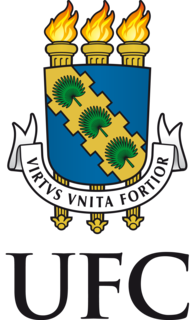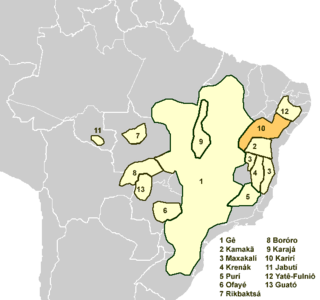Related Research Articles

Fortaleza is the state capital of Ceará, located in Northeastern Brazil. It belongs to the Metropolitan mesoregion of Fortaleza and microregion of Fortaleza. It is Brazil's 5th largest city and the twelfth richest city in the country in GDP. It also has the third richest metropolitan area in the North and Northeast regions. It is an important industrial and commercial center of Brazil, the nation's eighth largest municipality in purchasing power. According to the Ministry of Tourism, the city reached the mark of second most desired destination of Brazil and fourth among Brazilian cities in tourists received. The BR-116, the most important highway of the country, starts in Fortaleza. The municipality is part of the Common Market of Mercosur Cities, and also the Brazilian state capital which is closest to Europe, 5,608 kilometres (3,485 mi) from Lisbon, Portugal.

Ceará is one of the 27 states of Brazil, located in the northeastern part of the country, on the Atlantic coast. It is the eighth-largest Brazilian State by population and the 17th by area. It is also one of the main tourist destinations in Brazil. The state capital is the city of Fortaleza, the country's fourth most populous city. The state has 4,3% of the Brazilian population and produces only 2,1% of the Brazilian GDP.

The Federal University of Ceará is a federal university with campuses in the cities of Fortaleza, Sobral, Barbalha, Russas, Quixadá and Crateús, in the state of Ceará, Brazil. UFC is a public and tuition-free university, with several academic programs in most areas of knowledge.

Ceará Sporting Club, or Ceará, as they are usually called, is a Brazilian football team from the city of Fortaleza, capital city of the Brazilian state of Ceará, founded on June 2, 1914 by Luís Esteves e Pedro Freire. Ceará is one of the most traditionally successful clubs in the Northeast region of Brazil alongside Bahia, Santa Cruz, Sport, Náutico, Vitória and their city rivals Fortaleza.

The Estádio Governador Plácido Castelo, also known as the Castelão or Gigante da Boa Vista, is a football stadium that was inaugurated on November 11, 1973 in Fortaleza, Ceará, Brazil, with a maximum capacity of 63,903 spectators. The stadium is owned by the Ceará state Government, and is the home ground of Ceará Sporting Club and Fortaleza Esporte Clube. Its formal name honors Plácido Aderaldo Castelo, who served as the Governor of Ceará from September 12, 1966 to March 15, 1971, and was a leader in getting the stadium built.

The Karirí languages, generally considered dialects of a single language, are extinct languages formerly spoken by the Kiriri people of Brazil. It was spoken until the middle of the 20th century; the 4,000 ethnic Kiriri are now monolingual Portuguese speakers, though a few know common phrases and names of medicinal plants.

Onciderini is a tribe of longhorn beetles of the subfamily Lamiinae, they are prevalent across Europe in nations such as Turkey, and Finland.

Trestonia is a genus of longhorn beetles of the subfamily Lamiinae, containing the following species:
Luiz Carlos Cirne Lima de Lorenzi, commonly known as Lisca, is a Brazilian football manager.
Trestonia albilatera is a species of beetle in the family Cerambycidae. It was described by Francis Polkinghorne Pascoe in 1859. It is known from Brazil.
Trestonia assulina is a species of beetle in the family Cerambycidae. It was described by Henry Walter Bates in 1874. It is known from Nicaragua, Costa Rica, and Panama.
Trestonia capreola is a species of beetle in the family Cerambycidae. It was described by Ernst Friedrich Germar in 1824. It is known from Brazil, Argentina and Paraguay.
Trestonia confusa is a species of beetle in the family Cerambycidae. It was described by Dillon and Dillon in 1946. It is known from Colombia, Costa Rica and Panama.
Trestonia fasciata is a species of beetle in the family Cerambycidae. It was described by Martins and Galileo in 1990. It is known from Colombia.

Trestonia frontalis is a species of beetle in the family Cerambycidae. It was described by Wilhelm Ferdinand Erichson in 1847. It is known from Brazil, Ecuador, Bolivia, Colombia and Peru.
Trestonia grisea is a species of beetle in the family Cerambycidae. It was described by Martins and Galileo in 1990. It is known from Brazil.
Trestonia nivea is a species of beetle in the family Cerambycidae. It was described by Martins and Galileo in 1990. It is known from Brazil, Surinam and French Guiana.
Trestonia pulcherrima is a species of beetle in the family Cerambycidae. It was described by Dillon and Dillon in 1946. It is known from Panama and Costa Rica.
Trestonia pyralis is a species of beetle in the family Cerambycidae. It was described by Dillon and Dillon in 1946. It is known from Panama and Costa Rica.
Trestonia rugosicollis is a species of beetle in the family Cerambycidae. It was described by Martins, Galileo and de Oliveira in 2009.
References
- ↑ BioLib.cz - Trestonia ceara. Retrieved on 8 September 2014.